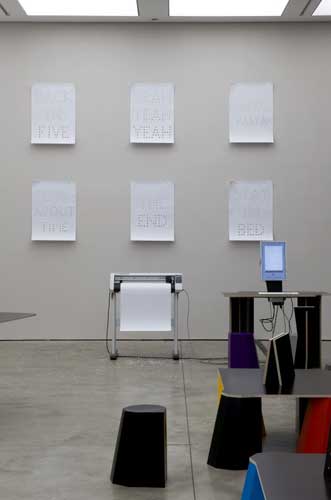A Recent History of Writing and Drawing, ICA, London
A computer may have created the works, but they have a cheeringly human feel

The risky thing about newness is how old it can suddenly seem. Hardly a decade ago, the Turner Prize-winning artist, Keith Tyson, began taking orders from a tyrannical object he dubbed The Artmachine. Whether this infernal apparatus actually existed – no one ever saw it – hardly matters. In Tyson's telling, the Artmachine generated algorithms, and these algorithms – a type of self-perpetuating mathematical formula – dictated to the artist the kind of art he was to make. Bound up in this process was the nightmare vision of an Arthur C Clarke world run by HAL the Computer, a postlapsarian place where man's genius had ended in his enslavement.
So you might approach the Institute of Contemporary Arts' show, A Recent History of Writing and Drawing, with a degree of trepidation, or possibly two. The exhibition is a collaboration between Jürg Lehni, a Swiss designer/developer/artist (forward slashes are big at the ICA) and graphic designer Alex Rich.
In 2002, Lehni invented a machine named Hektor with a software programme called Scriptographer. Roughly, Scriptographer allowed someone sitting at a computer keyboard to tell Hektor, a robot with a spray-can, what kind of art to make. Check out Hektor's website (hektor.ch) and you can watch the game little fellow painting a mural called In a Beautiful Place Out in the Country. The work, in black aerosol on a white wall, looks loosely gestural, which is apt enough since it is in the tradition of Sol LeWitt. Now, Viktor, Son of Hektor, is the centrepiece of the ICA show. With four motors to his parent's two, and working in chalk rather than paint, Viktor will be operated by a variety of artists/designers/developers during his six-week stay, Ryan Gander being the most famous among them.
If the hands-off determinism of Lehni and Rich's project worries you, then its echoes of Tyson may do so as well. There is nothing sadder than yesterday's robot. Actually, though, Viktor is not so much the Artmachine's double as its nemesis.
Look at Lehni's brainchild at work and you will be struck by the glorious imprecision of it all. Viktor's planchette is operated by flexible steel bands whose movement is jerky and proximate: the chalk marks it makes on the ICA's blackboard-wall look like an Etch-A-Sketch. If Tyson's Artmachine looked to a threatening future, Viktor evokes an Amstrad-y past.
We live in a society addicted to slickness. The graphics we see – the type these words are set in – have been buffed to perfection, their serifs tidied up by computers like the one that drives Viktor. There is nothing in the font you're reading to suggest the touch of my fingers. Perfection equals abstraction or, if you prefer, dehumanisation. What Lehni and Rich's various machines set out to do is to re-humanise technology – to show that we dictate the kind of art machines make rather than the other way about.
Thus, unexpectedly, the mood in the ICA's lower galleries is of cheery clunkiness rather than Luddite terror. Although you won't be allowed to drive Viktor yourself – this is art, after all – you can make your own artwork/ poster using a machine called Dots on Demand. Typing in a sentence of your choice – prototypes included "IT'S ABOUT TIME" and "STAY IN BED" – instructs a paper-cutter to punch out dot-words in printer-paper. You can take the results home with you, although the ICA will keep a copy. (Every man his own artist. Technology isn't just fun, it's democratising.)
If that doesn't do it for you, you can play around on a workstation called News on Demand. Pressing the button on an aerosol pen hooked up to a wire service allows you to write the latest news in whatever form you choose: thus I drew a picture of a little dog whose outline turned out to be made up of the words "Pair held in botched gas suicide". Aw.
The point of all this, I'd guess, is to reinstate the hand in modern life. A Recent History of Writing and Drawing is what it says it is, an examination of the world we live in, of the marks it makes. The recent measure of civilisation has been the hand's removal from the manual – a mood that has seen, among other things, the decline of skill in art and the rise of conceptualism. The installation doesn't encourage skill, in fact it rather forbids it. But it will be interesting to see how Viktor's various operators try to outsmart him none the less, and to muse on what that might mean.
To 31 Aug (020-7930 3647)
Join our commenting forum
Join thought-provoking conversations, follow other Independent readers and see their replies
Comments
Bookmark popover
Removed from bookmarks